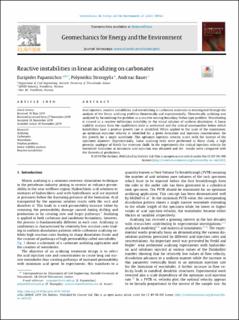| dc.contributor.author | Papamichos, Euripides | |
| dc.contributor.author | Strongylis, Polyneikis | |
| dc.contributor.author | Bauer, Andreas | |
| dc.date.accessioned | 2020-10-14T12:01:39Z | |
| dc.date.available | 2020-10-14T12:01:39Z | |
| dc.date.created | 2020-09-22T11:57:59Z | |
| dc.date.issued | 2020 | |
| dc.identifier.citation | Geomechanics for Energy and the Environment. 2020, 21 . | en_US |
| dc.identifier.issn | 2352-3808 | |
| dc.identifier.uri | https://hdl.handle.net/11250/2682817 | |
| dc.description.abstract | Acid injection, reactive instabilities and wormholing in carbonate reservoirs is investigated through the analysis of the linear acidizing problem theoretically and experimentally. Theoretically acidizing was analyzed by formulating the problem as a reactive moving boundary Stefan type problem. Wormholing is viewed as a reactive infiltration instability to the trivial solution of uniform dissolution. A linear stability analysis from the equilibrium state is performed and the critical wavenumber below which instabilities have a positive growth rate is identified. When applied to the scale of the experiment, an optimum injection velocity is identified for a given formation and injection concentration, for the growth for a single wormhole. This optimum injection velocity scales with the inverse of the specimen diameter. Experimentally, linear acidizing tests were performed in Mons chalk, a high porosity analogue of North Sea reservoir chalk. In the experiments the critical injection velocity for wormhole formation at minimum acid injection was obtained and the results were compared with the theoretical predictions. | en_US |
| dc.language.iso | eng | en_US |
| dc.publisher | Elsevier | en_US |
| dc.subject | Acidizing | en_US |
| dc.subject | Carbonates | en_US |
| dc.subject | Wormholes | en_US |
| dc.subject | Stephan problem | en_US |
| dc.subject | Linear stability analysis | en_US |
| dc.subject | Reactive instabilities | en_US |
| dc.title | Reactive instabilities in linear acidizing on carbonates | en_US |
| dc.type | Peer reviewed | en_US |
| dc.type | Journal article | en_US |
| dc.description.version | publishedVersion | en_US |
| dc.rights.holder | © 2019 The Authors | en_US |
| dc.source.pagenumber | 15 | en_US |
| dc.source.volume | 21 | en_US |
| dc.source.journal | Geomechanics for Energy and the Environment | en_US |
| dc.identifier.doi | 10.1016/j.gete.2019.100161 | |
| dc.identifier.cristin | 1832046 | |
| cristin.ispublished | true | |
| cristin.fulltext | original | |
| cristin.qualitycode | 1 | |
